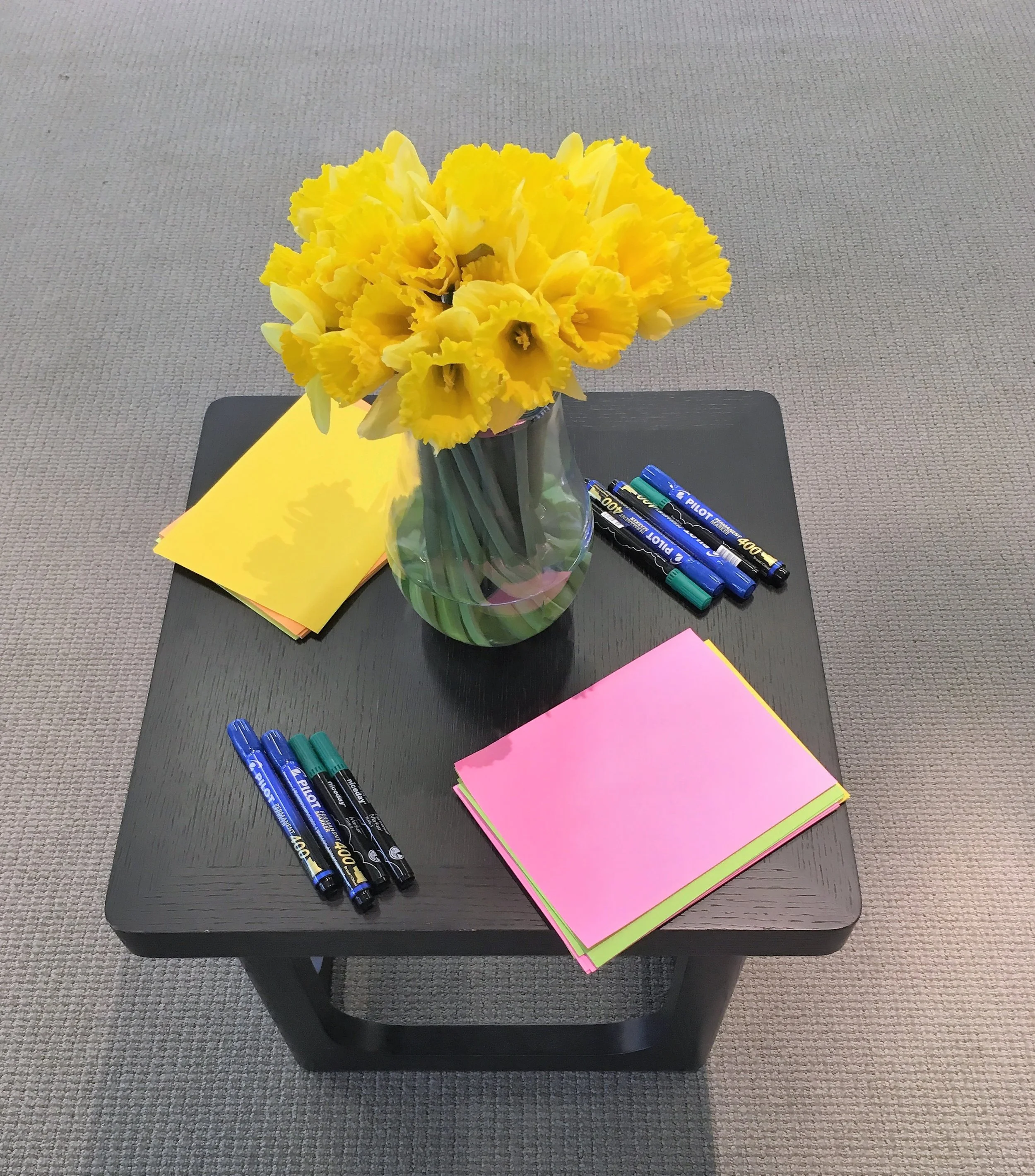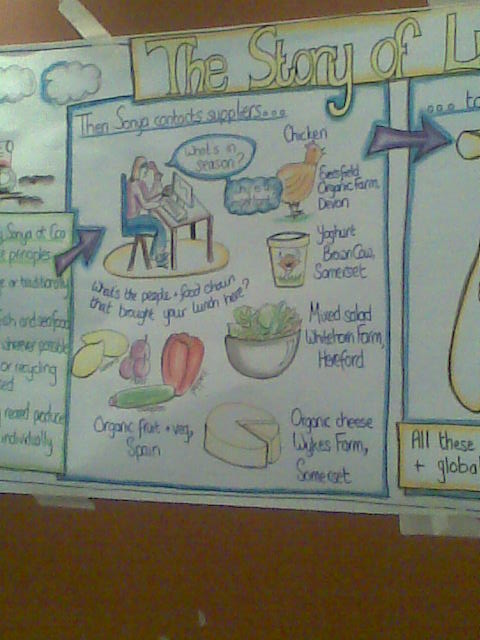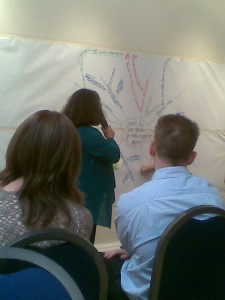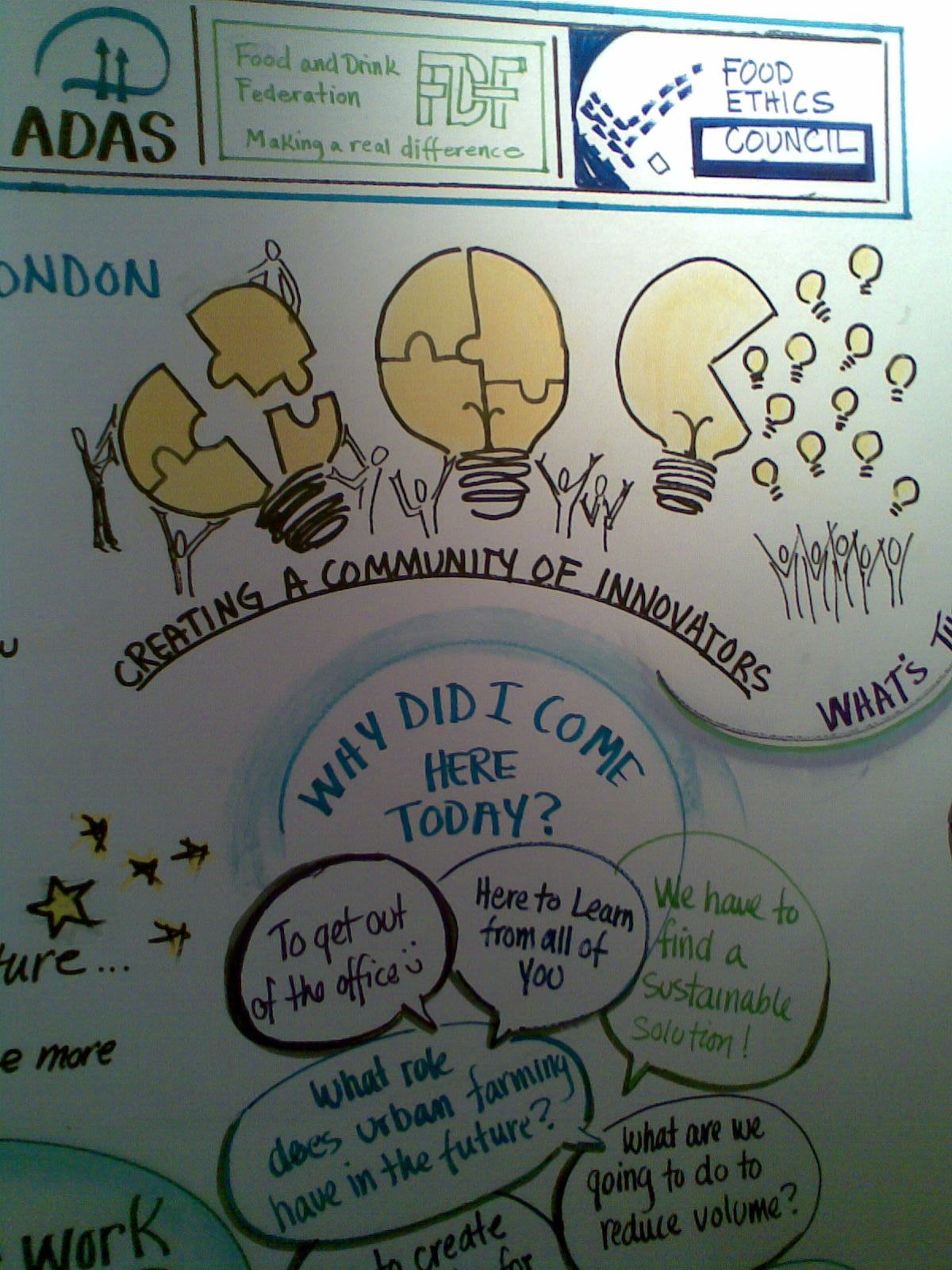We’re pretty used to asking people to talk in small groups, but which kinds of groups work best for different kinds of conversations? If you’ve scratched your head wondering how to form small groups, take a look at these options.
Paying attention to the mood
When I first met with Brigid Finlayson and Carolina Karlstrom, to see whether we could work together to create the first She is Still Sustainable, we talked a lot about the kind of event we wanted to make it. And our conversation focused a lot on mood, atmosphere, emotional tone: we wanted it to be “warm, safe, friendly event which is refreshing, inspiring and supportive”.
She is Sustainable - sustaining the sustainers
Vertically, horizontally or circularly ambitious? Mothering or child-free, by choice or randomness? Urban or rural? Partnered for life or a free agent? Gay or straight or something else? Employed, entrepreneur or freelance?
Women who work in sustainability are all these things and more.
She is Sustainable was invented by five UK-based sustainability women (Becky Willis, Solitaire Townsend, Amy Mount, Hannah Hislop and Melissa Miners) who thought…
Occupy movement: the revolution will need marker pens
On my bike, between meetings last week, I was passing St Paul's Cathedral in London so I wandered through the Occupy London Stock Exchange 'tent city'. Occupy LSX has divided opinion. At the meeting I was going to - a workshop of organisational development consultants, facilitators, coaches - some people made rather snide remarks about the likely impact of the first cold weather on the protesters, and about unoccupied tents. There's a retort here about the infamous thermal imaging scoop. Others were interested in and sympathetic to the dissatisfaction being expressed, but frustrated by the lack of a clear 'ask' or alternative from the occupiers.
Emergent, self-organising, asks and offers
What struck me, however, were the similarities between the occupy area itself, and some really good workshops I've experienced. There was plenty of space given aside for 'bike rack', 'grafitti wall' and other open ways of displaying messages, observations or questions. There was a timetable of sessions being offered in the Tent City University, and another board showing the times of consensus workshops and other process-related themes.
There was a 'wish list' board, where friendly passers-by could find out what the protesters need to help keep things going. Marker pens and other workshop-related paraphernalia are needed, as well as fire extinguishers and tinned sweetcorn.
I saw these as signs of an intentionally emergent phenomenon, with a different kind of economy running alongside the money economy. Others have blogged about the kinds of processes honed and commonly in use at this kind of event or camp, in particular if you're interested there's loads on the Rhizome blog.
Don't ask the question if you don't already know the answer?
I recognise the frustration expressed by some of my OD colleagues about the lack of clearly-expressed alternatives. This kind of conversation often occurs in groups that I facilitate: someone (often not in the room) has expressed a negative view about a policy, project or perspective. The people in the room feel defensive and attack the grumbler: "I bet they couldn't do any better" or "what do they expect us to do?". Some management styles and organisational cultures are fairly explicit that they don't want to hear about problems, only solutions. (Browsing here gives some glimpses of the gift and the shadow side of this approach.)
But I see something different here: a bottom-up process where people who share broadly the same intent and perspective, come together to explore and work out what they agree about, when looking at the problems with the current situation and the possible ways of making things better. The are participatively framing a view of the system as it is now, and what alternatives exist. This takes time, of course.
They are also, as far as I can tell from the outside, intentionally using consensus-based processes rather than conventional, top-down, leader-led or expert-led processes to organise this. Understandably frustrating for the news media which rely increasingly on short sound-bites and simple stories with two sides opposing each other. And it could get very interesting when the dialogue opens up to include those who have quite different perspectives on "what's really going on here" (for example mainstream economists, bankers, city workers).
The other thing I notice about this expectation of a ready-made coherent answer, is how similar it is to some group behaviour and the interventions made by inexperienced facilitators and coaches. When I am training facilitators, we look at when to intervene in a group's conversation, particularly when to use the intervention 'say what you see'. (This makes it sound very mechanical - of course it's not really like that!)
The trainee facilitator is observed practising, and then there is feedback and a debriefing conversation. Perhaps they chose not to intervene by telling the group what they observed. Sometimes during this feedback and debrief, a trainee will say something like "Yes, I noticed that, but I didn't want to say anything because I wasn't sure what to do about it or what it meant." They are assuming that you can only 'say what you see' if you know what it means and already have a suggestion about what to do about it.
But it also serves a group to say what you see, when you haven't a settled interpretation or clear proposal. (In fact, it is more powerful to allow the group to interpret, explain and propose together.) All questions are legitimate, especially those to which we don't (yet) know the answer. Ask them. Guess some answers. And this - for the time being - is what the occupy movement is doing.
The revolution will need marker pens
All this consensus-based work and open-space style process needs plenty of marker pens (permanent and white-board). So if you have a bulging facilitation toolkit and you're passing St Paul's, you know what to do!
Update
Others have spotted these connections too. Listen to Peggy Holman talking about Occupy Wall Street on WGRNRadio, 9th January.
Multi-stakeholder collaboration - some headline sources
This blog entry is written for a very specific reason: I've just advised a group of people to look at my blog for initial sources on multi-stakeholder collaboration... but reviewing the blog I realise that it'll be quite hard to find the things I mean, and some of them I haven't even written about yet! So, especially for them - and for you, dear other readers - here's a quick brain dump of key sources and ideas which I think form a good set of starting points, mostly from my own experience. Which means that if you have other great resources to tell people about, please do post them in the comments box.
Examples
There are some really interesting examples from the UK of the Environment Agency spending quite a lot of time and resources thoughtfully engaging in conversations with communities and other stakeholders when considering flood defences and coastal erosion risk. For example, Shaldon and Medmerry [transparency alert - I worked on the Medmerry project] where engagement with stakeholders was carefully planned so that people could influence the decisions which the project team was making as the plans developed. Both schemes are ongoing. See for example this report from the UK's Sustainable Development Commission which includes Shaldon as an example, and this short case study from the Environment Agency on Shaldon. A search using 'environment agency', shaldon, stakeholder and 'liaison group' will bring up other interesting views on the engagement approach and its success.There's a bit more about the EA's ground-breaking work in this area in this article on DAD/EDD.
Another place-specific collaborative approach is described in this article "Human Systems Intervention And The Natural Step" by Jenny Sardone & Magdalena Szpala, first published in AMED's Organisations and People journal. I believe that it's not available electronically, but I'm trying to chase down an e-version so I can link to it.
Much better known are the FSC and the MSC - now well-established multi-stakeholder organisations which tried to 'get the whole system in the room' to work out credible consensus-based criteria for what might be considered sustainable management of forest and marine resources. They have had varying degrees of success over the years in getting buy-in from all the different interests (environmental, social, economic). I wrote about the MSC a few years ago, an article called plenty more fish in the sea. Current examples include WWF-UK's Tasting the Future, Forum for the Future's work on tourism, and CPSL's work on both climate and insurance. Some of these have crystalised into organisations, others are more fluid than that: fellow travellers collaborating with intention.
Theories, techniques and patterns
Fascinating to ponder on what the circumstances are which bring about authentic whole-system engagement, and what you have to do to get the right people in the room in the first place, and then to keep up the momentum. The best resource I know of at the moment on this is Peggy Holman's Engaging Emergence. But I'm sure there are lots of others: please help me collect them by posting your favourites in the comments box.
Favourite techniques which can help include World Cafe, Open Space Technology and Future Search. I've blogged about the first big Tasting the Future meeting here, which combined a number of techniques.
SDC resources on collaboration, dialogue, engagement
Since its demise, it's really hard to find the engagement resources on the SDC's website. So here are some direct links to some of them:
- SDC's response to National Framework for Greater Citizen Engagement (2008)
- Final report on the SDC's Supplier Obligation stakeholder and public engagement process "Household Energy from 2011", with a description of process and findings. There are links to other documents about this process here. [Transparency alert - I worked on the Supplier Obligation project.]
- An independent evaluation report about the SDC's Engagement in Tidal Power process, which brought together stakeholders and the public to think about criteria and issues in harnessing power from the tides.
- The groundbreaking and really rather wonderful (for process geeks) guidance on designing engagement, published by the SDC but drawing on pioneering work done by InterAct Networks (Lindsey Colbourne, Lynn Wetenhall, Jeff Bishop, Richard Harris and others) and developed through practitioners at the Environment Agency among others. This work continues, for example through work Sciencewise-ERC has done with DECC.
- Some specific gems from this guidance include 'engagement and the policy making cycle' and a 'typology of engagement' and some definitions of different kinds of engagement. [More transparency - I work regularly with Sciencewise-ERC and as of 2011 am a Director of InterAct Networks]
Add your wisdom
This has been a very rapid post, and most of the examples and ideas are those which I'm personally familiar with. There must be lots of others, including some great compilation resources. Please use the comments space to link to your favourites and to critique what I've posted here.
Tasting the Future – tangy fresh process
As you may have noticed, I'm a process aficionado. I love to hear about innovative ways of helping people have the conversations they need. I love to try out new processes as a facilitator and a participant. I network with fellow facilitators through AMED, the IAF and a facilitators' group on linked-in. I read about unorthodox approaches, and sometimes I even try them with paying clients.
On Monday, I had the great treat of being a participant in someone else's workshop. There I saw for real - not in a training setting - open space, world cafe, graphic facilitation and live plenary mind mapping all used during the same meeting.
The event was the first 'assembly' for Tasting the Future, a collaborative whole-systems attempt to innovate the food system. It was organised by WWF, ADAS, the Food and Drink Federation and Food Ethics Council. Facilitation was provided by Hara Practice and Natural Innovation and other members of the hosting team. There were also some people doing graphic recording, from Intuitive Intelligence Training.
Some exciting conversations and actions emerged, and you can read more about them on the Tasting the Future ning. I'm going share some of the things I learned about process.
Dressing the room
When we arrived we sat where we liked at small tables covered with flip chart paper, with a small stack of coloured pens, crayons and chalk. There were small bowls of sweets and a colourful cartoon diagram introducing us to world cafe. And on each table there was a unique food or herb seedling, grown at Hackney City Farm, which you could buy to take home if you liked. Plants included apple mint, chamomile, lettuces, cabbage and tomato.
There was also this great picture story of our lunch: very appropriate for an event like this.
Setting the tone
There were a couple of phrases I scribbled down during the opening session. The hosting team asked us to be strong enough to work with our differences, to become a community of innovators, to speak with intention. We were invited to 'listen louder' if we disagreed with what someone was saying, so that we could better understand their perspective rather than blot it out with our own.
Meta-planning
Following couple of rounds of world cafe, we were asked to come up with our best ideas about what we wanted to change in the current system. We wrote these on A5 size stickies, and these were then meta-planned (clustered) in plenary. Bear in mind there were over 100 participants, and the facilitators among you will recognise the audacity of this. The hosting team had mikes and runners, and the lead facilitator began as usual by asking for any one idea. She then asked people with the same idea on their sticky note to shout 'snap!'. This was a great way of gathering up the clusters very rapidly. A supporter did the actual sticking up, while the facilitator asked for the next idea. It didn't take long for all the ideas to be gathered and clustered.
Whole group mind-mapping
Another daring bit of process for such a large group was the method used to identify topics for the subsequent open space session on action planning. We all gathered around a long wall, where a large blank area of paper was taped up.
The focus question was posed: "Where do we need to take action?". (Actually there was an adjective in there, but my memory and my photo have let me down. Could've been 'where do we need to take collective action' or 'urgent action'.) Then the facilitator asked us to write our name legibly on a sticky note if we had an idea we wanted to add to the mind map. Rules for the mind map included that there's no such thing as a bad idea, it's fine to disagree with a previous idea, and the owner of the idea gets to say where on the map it goes. There were support facilitators collecting up the names so the lead facilitator could call people by name. Other members of the team had mikes and ensured each person making a contribution could be heard. Two of the team were scribes, with four colours of marker pens. As a new theme and idea was added, the scribes would write it up on the evolving map.
One at a time, those who wanted to offered ideas for action, and said whether they were twigs to add to existing branches, or new branches. This went on for about 30 minutes. It was beautifully controlled, and everyone who wanted to had an opportunity to contribute.
When the mind map was complete, we were each given three dots and invited to use them to indicate which actions we thought were the most important. Over tea, the dots were counted and around a dozen action areas were identified which had enough support to be the topics for the subsequent open space action planning session.
Open space
Over tea the room was rearranged so there was one large circle in the middle. The topics which had emerged from the mind map were written up on large pieces of paper, each with a number which corresponded to a numbered part of the room. The method of sorting out who went to which session was simpler than I'd seen before. There was no signing up of participants to different topics, or assigning topics to time slots. Instead, there was one 50 minute time slot. Within that time, participants could go to whichever topic they wanted, and leave it whenever they wanted. This is the law of two feet. Topics were hosted by volunteer hosts, who put themselves forward while the open space was being organised. If a topic didn't have a host, it didn't run. There was also the opportunity for hosts to offer additional topics, and I think one was proposed at this stage.
Very soon we were ready to go to our spaces and discuss our topic. The host had a prepared flip where they were asked to record key information: topic title, who hosted, who participated, three key points to share and actions the group would take (if any). The guidance was very clear on actions: they were to be things someone in the group had agreed to take on, not recommendations for action by others. As the facilitator said "We're the ones we've been waiting for".
Graphic recording
As the day progressed, a team of graphic recorders captured the highlights in this lovely illustration.
Update
There have now been three Assemblies and other meetings and workshops as part of Tasting the Future. Check out the prospectus for more details.

















